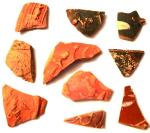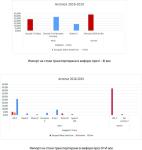Summary (English)
AGATHOPOLIS (Diana Gergova – dianagergova@gmail.com, Nadezhda Ivanova, Galina Grozdanova) The explorations of the spoil heaps originating from destroyed strata continued. The finds included three silver tetartemoria of Apollonia of 479 – 460 BC, a coin of Mesambria of the 4th century BC, coins of the Thracian kings Mostis (110 – 85 BC) and Kotys (c. 105/100 – 90 BC), coins of the 4th – 6th centuries AD, including of Justinian I and minted in Nicomedia in the 6th century AD, a Byzantine lead seal of the 9th – 10th century AD and a Byzantine follis of the 10th – 11th century AD. Sherds from Thracian pottery of the 5th – 1st centuries BC and pottery of the Roman, Late Antique, Mediaeval and Ottoman periods were found. A Thracian sherd of the Early Iron Age was the earliest one. The pottery also included sherds from Megarian bowls, fragments from Hellenistic roof-tiles, one of them with a stamp that reads: A, amphorae of the 1st – 3rd centuries AD and Late Antiquity. During the 1st century BC – 1st century AD, the import of wine prevailed; amphorae of the Dressel 2-4 Types of Kos, Halicarnassus and Heraclea Pontica were discovered. During the 2nd century AD, the import of wine from Kos and the Western Anatolian coast continued, while the wine from Heraclea Pontica was transported in amphorae of the Shelov C Type. Judging from the amphorae of the Dressel 24 / Dressel 24 Similis Types, the import of olive oil from Chios, Kos, Knidos, Smyrna, Phocaea and Pergamon was most intensive during the second half of the 2nd – first half of the 3rd centuries AD. During the 4th – 6th centuries AD, there was import of olive oil in amphorae of the LRA 2 Type of Western Anatolia (mostly Phocaea, Cyme and Pergamon), supplemented with import from Cilicia in amphorae of the San Lorenzo 7 Type. Judging from the amphorae of the LRA 2 Type, the import of olive oil was most intensive during the 6th century AD. During the 4th century AD, the import of wine was carried out in amphorae of the Shelov E and Shelov D Types of Heraclea Pontica, while during the 5th – 6th centuries AD the import was carried out in amphorae of the Kuzmanov 9 and D Snp I Types of Sinope and in LRA 1 Type. Until the end of the 4th century AD, the wine was also imported in amphorae of the Agora G199 Type of Cilicia, LRA 1 Type of Cilicia, Cyprus and Western Anatolia and Torone III Type of Western Anatolia. Judging from the amphorae of the LRA 1 Type, the import of wine was most intensive during the second half of the 5th – 6th centuries AD. Byzantine glazed pottery was found, including white clay pottery of the GWW II and IV Classes dated from the middle of the 12th to the beginning of the 13th century, painted sgraffito and pottery with monograms. Amphorae of the Gunsenin Type I were also found.
- Diana Gergova - Archaeological Institute with Museum
- Nadezhda Ivanova - Archaeological Institute with Museum
- Galina Grozdanova - Archaeological Institute with Museum
Director
- Diana Gergova - Archaeological Institute with Museum
- Galina Grozdanova - Archaeological Institute with Museum
- Nadezhda Ivanova - Archaeological Institute with Museum
Team
Research Body
- Archaeological Institute with Museum






![Download [PDF]](/excavation/skins/fasti/images/results/download_sml.png)

